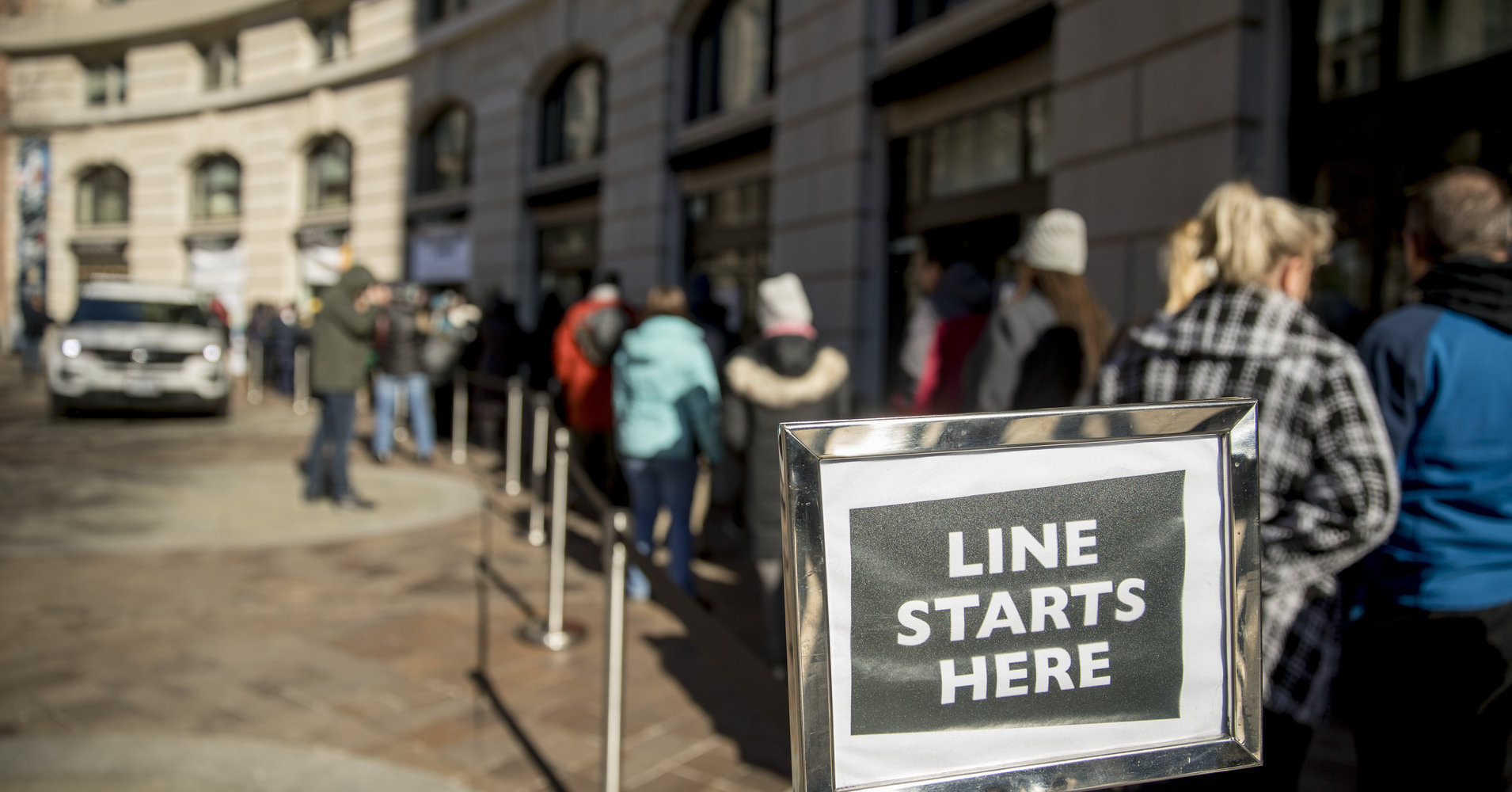[ad_1]

Marian Lewis noticed something weird after she bought a cup of yogurt over the weekend.
Her receipt showed that she had more than $120 on her electronic benefit transfer card, the piece of plastic that replaced the actual stamps of the original food stamp program. The amount should have been much lower because the New York City resident normally receives her benefits near the beginning of the month and spends them within a week.
“I thought I should have about $10 left,” she said. “What the heck is this?”
Lewis, 82, was afraid the government had erroneously deposited extra money on her card. And she had just used some of it ― was she going to have to pay it back? She thought she would have to visit her local Supplemental Nutrition Assistance Program office, in Harlem, and sort out the problem.
But then she heard on the radio that there had been no mistake ― the Trump administration had decided that because of the government shutdown, it would distribute the food benefits that 38 million people would normally receive in February weeks early in an attempt to make sure that month’s benefits were paid before the program’s money ran out.
The U.S. Department of Agriculture, which administers SNAP, has not announced a plan for March. Suspending benefits or paying them partially could have catastrophic consequences ― decimating household budgets and even provoking widespread hunger.
With a $65 billion annual cost, food benefits are one of the government’s biggest and most important domestic programs. The expansion of the earlier food stamp program in the 1960s and ’70s helped eradicate starvation in the U.S. The average allotment is about $123 per month per person, and no previous shutdown interrupted benefits.
The current shutdown started in December because President Donald Trump wouldn’t agree to fund some of his own government’s basic operations unless congressional Democrats agreed to appropriate $5.7 billion for a wall on the U.S.-Mexico border. And since the shutdown started, Trump has said he’s willing to continue the shutdown for years.
Payments, But No Plan
It’s unclear whether most beneficiaries had any idea the government had improvised a shutdown workaround that would distribute February benefits so far in advance. The USDA told states to get the money out but didn’t also tell them how to get the word out. States have been relying on social media posts, like the one below, and media stories to raise awareness, but many beneficiaries were unclear on the change. Several told HuffPost they were surprised to receive the funds.
Toni Victoria Lambert found out when her 18-year-old son told her their balance was over $500 when he went to the grocery store in Philadelphia this week. She then saw chatter on the neighborhood phone app NextDoor about how February’s SNAP benefits were coming early, but that no one knew what would happen in March.
“Maybe they didn’t have the money to send the letters” to tell recipients benefits were coming early, she told HuffPost.
Without clear information from the government, rumors can flourish. Beth Taurasi, from Colorado, said she heard from a fellow SNAP recipient that if the shutdown continues past February, the Trump administration would try to replace food benefits with boxes of canned goods ― an idea that nobody in Washington has actually suggested as a solution. (The Trump administration did suggest partially replacing SNAP benefits with food boxes last year, though the idea had not been thought out very well and it went nowhere.)
Lambert is already worried about what will happen come March ― she thinks she’ll need to rely on food pantries.
“I’m pretty creative with a potato and an onion,” she said, as she knows she’s going to need to stretch her food. “But you know just day-to-day stuff ― like little stuff, like on the weekends, what do you have for breakfast?”
The liberal Center on Budget and Policy Priorities pointed out that even if the shutdown ends by March, the gap between February’s early distribution and when funds will go out in March will leave beneficiaries stretching their SNAP dollars for as many as 50 days instead of the typical 28 to 31 days ― even though a gap that long violates the SNAP law.
Most SNAP recipients use up their benefits before the end of the month ― usually half of benefits are redeemed in the first week. So these extra days could increase reliance on already stretched food pantries and social networks.
“Given the experience of the strain on low-income households’ budgets and community resources under normal SNAP issuance patterns,” CBPP senior fellow Dottie Rosenbaum wrote, “stretching that gap to 40 to 50 days or longer could create substantial hardship and hunger and sharply increase demand for local emergency food providers and other community social services providers.”
And the uncertainty of a total lapse in funding for March persists. While the USDA has not said what it will do, the agency has said it has $3 billion in a contingency fund that it could use. But the total cost of one month of food benefits is closer to $5 billion.
We have to rely on the programs the government is shutting down in order for us to eat.
Beth Taurasi, SNAP recipient
Sonny Perdue, the secretary of agriculture, declined to get into what would happen in March during a recent conference call with reporters. He said Congress has enough time to sort out funding and that Democrats ought to give in to Trump’s wall demands.
Some experts argue that the government should consider SNAP an “entitlement” like Social Security or Medicare, and keep paying for it despite not appropriating funds. Those programs continue to disburse payments during government shutdowns. The USDA has not responded to requests about the entitlement path.
“I would support that,” Sen. Debbie Stabenow (D-Mich.), the top Democrat on the Senate committee that oversees the USDA, told HuffPost earlier this month.
Fears About Food And Shelter Abound
The bickering in Washington misses a key point, said Lambert: People are about to go hungry.
“I deplore the back and forth they’re doing right now, as I can’t eat that. I can’t pay my rent with that. That doesn’t translate to money to me,” Lambert, the Philadelphia woman, said. “They get to go home tonight to houses with freezers in the basement ― I don’t have that. Every day it’s a push.”
Taurasi receives monthly Supplemental Security Income benefits that are not affected by the shutdown. She and her fiance are both blind and reply on SNAP for groceries and housing vouchers that pay a portion of their rent in Denver. Like SNAP, the fate of the vouchers is uncertain if the shutdown drags into March.
“We have to rely on the programs the government is shutting down in order for us to eat,” Taurasi, 32, said in an interview.
She and other assistance recipients are confused and worried about how an ongoing shutdown will affect their basic needs — food, shelter and overall well-being.
Toni Oliver, a disabled 62-year-old in Roanoke, Virginia, says that she’s stretching her food assistance as far as she can. But if the benefits run out in March, she worries she’ll be forced to choose between paying for food or rent ― and she could lose her home and have nowhere to go.
The federal government has shut down several times in the past when Republicans and Democrats in Congress couldn’t agree with the White House on spending. This shutdown is already the longest in history, and neither side has budged.
“I didn’t worry about the others [shutdowns] as they’ve been really short-lived, but this time he’s gone overboard,” Oliver said, referring to the president. “And the doctor wants to know why my blood pressure is up.”
Lewis, the 82-year-old New Yorker, said she is an excellent health thanks in large part to her good diet. She is a therapist and an activist who advocates against age discrimination. But she worries that if her food benefits lapse, she’ll have to rely on charity meals with less wholesome ingredients.
“I do my best to stay healthy, and it’s hard if I can’t choose my food,” she said.
HuffPost readers: Are you affected by the government shutdown? Email us about it. If you’re willing to be interviewed, please provide a phone number.
Do you have information you want to share with HuffPost? Here’s how.
[ad_2]
Source link

